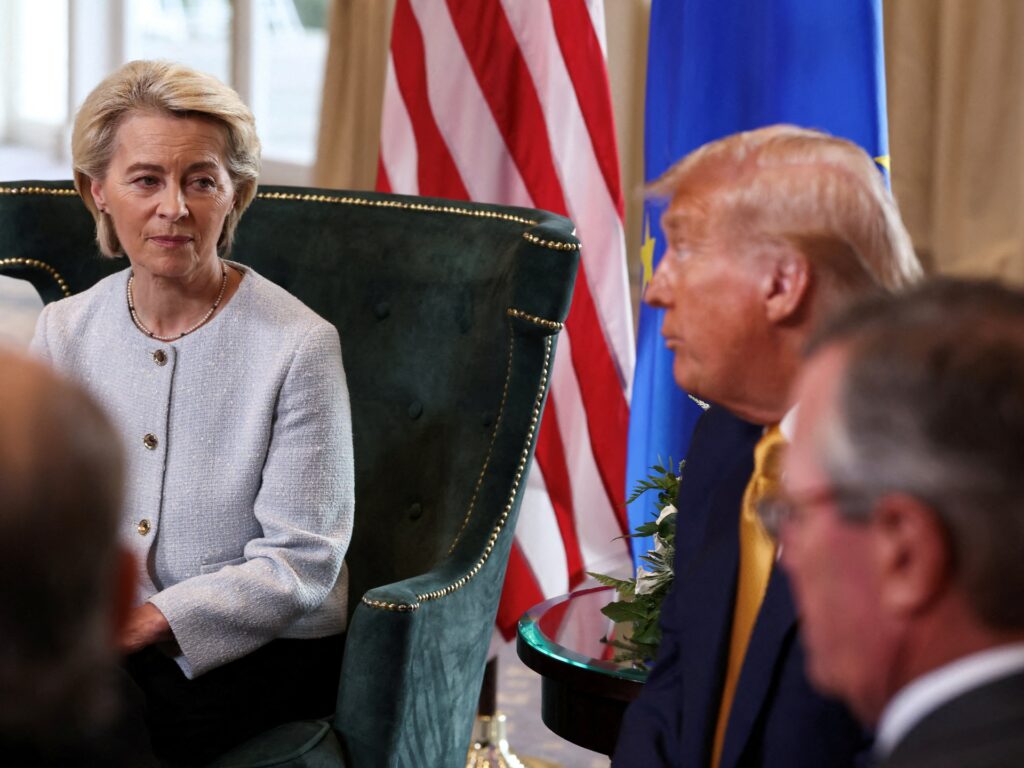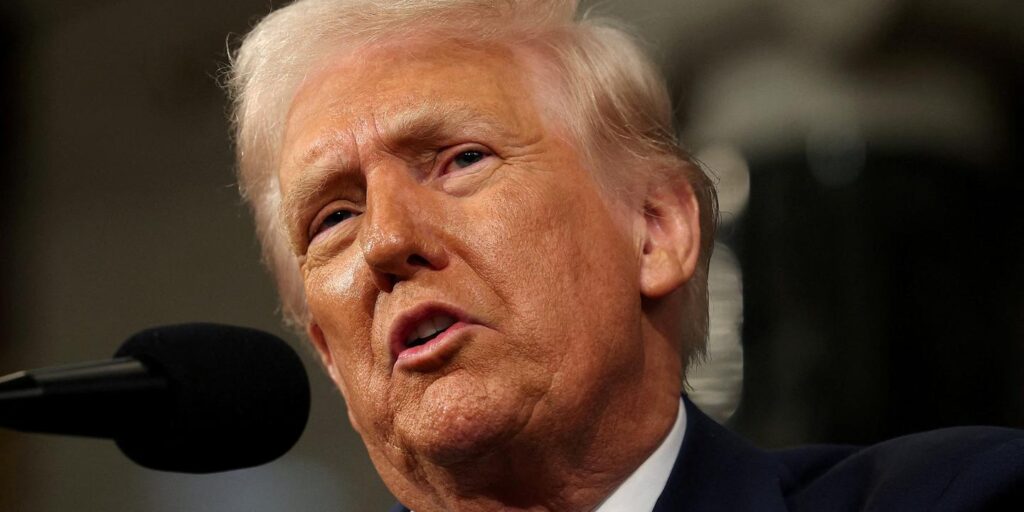The United States and the European Union have reached a wide-ranging trade agreement, ending a months-long standoff and averting a full-blown trade war just days before President Donald Trump’s deadline to impose steep tariffs.
The EU will pay 15 percent tariffs on most goods, including cars. The tariff rate is half the 30 percent Trump had threatened to implement starting on Friday. Brussels also agreed on Sunday to spend hundreds of billions of dollars on US weaponry and energy products on top of existing expenditures.
Speaking to reporters at his Turnberry golf resort in Scotland, Trump hailed the agreement as the “biggest deal ever made”. “I think it’s going to be great for both parties. It’s going to bring us closer together,” he added.
European Commission President Ursula von der Leyen said the agreement would “bring stability” and “bring predictability that’s very important for our businesses on both sides of the Atlantic”.
Von der Leyen defended the deal, saying the aim was to rebalance a trade surplus with the US. Trump has made no secret of using tariffs to try to trim US trade deficits.
Sunday’s agreement capped off months of often tense shuttle diplomacy between Brussels and Washington although neither side disclosed the full details of the pact or released any written materials.
It follows preliminary trade pacts the US signed with Japan, the United Kingdom, Indonesia, Vietnam and the Philippines and a 90-day trade truce with China.
So how will the deal impact the two sides, which account for almost a third of global trade, and will it end the threats of a tariff war?
What was agreed?
At a news event at Trump’s golf resort, von der Leyen said a 15 percent tariff would apply to European cars, pharmaceuticals and semiconductors – all important products for Europe’s economy.
For his part, Trump said US levies on steel and aluminium, which he has set at 50 percent on many countries, would not be cut for EU products, dashing the hopes of industry in the bloc. Elsewhere, aerospace tariffs will remain at zero for now.
In exchange for the 15 percent tariff rate on EU goods, Trump said the bloc would be “opening up their countries at zero tariff” for American exports.
In addition, he said the EU would spend an extra $750bn on US energy products, invest $600bn in the US and buy military equipment worth “hundreds of billions of dollars”.
Von der Leyen confirmed that the EU would seek to buy an extra $250bn of US energy products each year from now until 2027.
“With this deal, we are securing access to our largest export market,” she said.
At the same time, she acknowledged that the 15 percent tariffs would be “a challenge for some” European industries.
The EU is the US’s largest trading partner with two-way trade in goods and services last year reaching nearly $2 trillion.
How have European leaders responded?
German Chancellor Friedrich Merz welcomed the agreement, saying it avoids “an unnecessary escalation in transatlantic trade relations”.
He said a trade war “would have hit Germany’s export-oriented economy hard”, pointing out that the German car industry would see US tariffs lowered from 27.5 percent to 15 percent.
But French Prime Minister Francois Bayrou called the deal a “dark day” for Europe, saying the bloc had caved in to the US president with an unbalanced deal that spares US imports from any immediate European retaliation.
“It is a dark day when an alliance of free peoples, brought together to affirm their common values and to defend their common interests, resigns itself to submission,” Bayrou wrote on X of what he called the “von der Leyen-Trump deal”.
Wolfgang Niedermark, a board member of the Federation of German Industries trade body, called the deal “an inadequate compromise” with the EU “accepting painful tariffs”.
A 15 percent tariff rate “will have a huge negative impact on Germany’s export-oriented industry”, he said.
Earlier, Benjamin Haddad, France’s European affairs minister, said: “The trade agreement … will bring temporary stability to economic actors threatened by the escalation of American tariffs, but it is unbalanced.”
Echoing that sentiment, Dutch Foreign Trade Minister Hanneke Boerma said the deal was “not ideal” and called on the commission to continue negotiations with Washington.
The European Commission is responsible for negotiating trade deals for the entire bloc.
EU ambassadors will be discussing the agreement with the commission this week.
How was trade conducted before the deal?
On July 12, Trump threatened to impose 30 percent tariffs on EU goods if the two sides couldn’t reach a deal before this Friday, the day a suspension expires on the implementation of what Trump calls his “reciprocal tariffs”, which he placed on nearly all countries in the world.
Those “reciprocal tariffs” are due to come into effect in addition to the 25 percent tariffs on cars and car parts and the 50 percent levy on steel and aluminium products Trump already put in place.
On the European side, it is understood that Brussels would have pushed ahead with a retaliatory tariffs package on 90 billion euros ($109bn) of US goods, including car parts and bourbon, if talks had broken down.
The EU had been a frequent target of escalating trade rhetoric by Trump, who accused the bloc of “ripping off” the US.
In 2024, the US ran a $235.6bn goods deficit with the EU. Pharmaceuticals, car parts and industrial chemicals were among Europe’s largest exports to the US, according to EU data.
How will the deal impact the US and EU?
Bloomberg Economics estimated that a no-deal outcome would have raised the effective US tariff rate on European goods to nearly 18 percent on Friday.
The new deal brings that number down to 16 percent, offering a small reprieve to European exporting firms. Still, current trade barriers are much higher than before Trump took office in 2025.
According to Bruegel, a research group, the average US tariff rate on EU exports was just 1.5 percent at the end of 2024.
William Lee, chief economist at the Milken Institute, told Al Jazeera: “I think the (Trump) strategy has been clear from the very beginning. … It’s brinkmanship. … Either partner with the US or face high tariffs.”
Meanwhile, US Commerce Secretary Howard Lutnick said: “President Trump just unlocked one of the biggest economies in the world. The European Union is going to open its $20 trillion market and completely accept our auto and industrial standards for the first time ever.”


